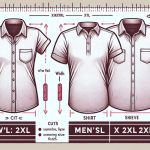I recently bought a pair of XL men's pants online, assuming they would fit perfectly based on my usual size. To my surprise, they were either too tight or too loose depending on the brand.
Understanding what size XL means in men's pants can be a perplexing task, with variations between different manufacturers and styles. So, how do you navigate this sizing maze to find the right fit for you?
Let's unravel the mystery of XL in men's pants together.
Table of Contents
Key Takeaways
- XL in men's pants typically corresponds to a waist size range of 40-42 inches.
- XL pants come in various fabrics with differences in leg length and rise options.
- Style preferences play a role in choosing XL sizes for the perfect fit.
- Consider key factors like fabric, rise, and inseam length for informed XL pants shopping decisions.
Understanding Men's Pant Sizing
When shopping for men's pants, understanding pant sizing can be essential to finding the perfect fit. The two key measurements to bear in mind are waist measurements and inseam length. The waist measurement is the circumference of the waistband of the pants, usually measured in inches. It's important to measure your natural waist, which is typically located above the hip bones and slightly below the rib cage. This measurement helps determine where the pants will sit on your body.
Inseam length, on the other hand, is the distance from the crotch of the pants to the hem of the leg. This measurement is important for ensuring the pants are the right length for your legs. A proper inseam length will prevent the pants from dragging on the floor or being too short.
Different Sizing Systems Explained
Let's demystify men's pant sizing by exploring different sizing systems.
We'll navigate size conversion charts, learn how body measurements guide sizing, and uncover brand-specific variations.
Understanding these key points will help us confidently choose the right size when shopping for men's pants.
Size Conversion Charts
Understanding size conversion charts can be essential for comprehending different sizing systems across various clothing brands and regions. International conversions play a significant role in ensuring you select the right size when shopping for men's pants.
Different countries may have distinct sizing standards, so referring to a size conversion chart can prevent ordering the wrong size. Additionally, knowing about tailoring options and alterations can help fine-tune the fit of your pants if needed.
Body Measurements Guide
Understanding different sizing systems for men's pants requires grasping the body measurements guide for accurate fit across various brands and regions. When determining the right size, it's important to take into account your waist measurement and inseam length.
Waist measurement is vital as it guarantees the pants fit comfortably around your waist without being too tight or too loose. Inseam length, on the other hand, determines the pant leg's appropriate length, preventing it from being too short or too long.
Brand-specific Sizing Variations
Deciphering different brands' sizing systems for men's pants can be a challenge due to their brand-specific variations, which can lead to confusion when determining the right fit for your measurements. Understanding waist measurements and inseam lengths across various brands is important for finding the perfect pair of pants. Below is a comparison table outlining the sizing differences in men's pants among popular brands:
| Brand | Waist Measurements |
|---|---|
| Brand A | 32 inches |
| Brand B | 34 inches |
| Brand C | 36 inches |
| Brand D | 38 inches |
| Brand E | 40 inches |
XL Size in Men's Pants
When shopping for men's pants, determining the correct size can be essential, especially when it comes to XL sizes.
- Size Range: XL in men's pants typically corresponds to a waist size of 40-42 inches, but this can vary between brands.
- Fabric Options: Men's XL pants are available in various fabrics, including cotton, denim, polyester, and blends. Each fabric offers different levels of comfort and durability.
- Fit Considerations: XL sizes may differ regarding leg length and rise, so it's important to check the inseam and waist measurements for the best fit.
- Styling Tips: When opting for XL sizes, consider the style of the pants – whether they're slim fit, regular fit, or relaxed fit – to make sure they match your preferences and body type.
Understanding the nuances of XL sizes in men's pants, from the size range to fabric choices, can help you make informed decisions and find the perfect pair for your wardrobe.
Tips for Finding the Right Fit
When it comes to finding the right fit in men's pants, understanding size charts and knowing how to make fit adjustments can make a world of difference.
It's important to pay attention to measurements and consider alterations if needed for a perfect fit.
Size Chart Guidance
Browsing through the size chart guidance can help me find the right fit for men's pants. Here are some key points to ponder:
- Waist Measurements: Make sure you know your waist size accurately, as this is critical for finding pants that fit well.
- Inseam Lengths: Understanding your inseam length will help you choose pants that are the right length for your legs.
- European Sizing: Familiarize yourself with European sizing if you often shop for pants from European brands.
- Asian Sizing: Similarly, if you prefer Asian brands, be aware of the sizing differences that may exist in Asian sizing charts.
Fit Adjustment Tips
To guarantee the perfect fit for men's pants, consider trying on different sizes to find the most comfortable and flattering option. When it comes to waist sizing, make sure that the pants sit comfortably around your waist without being too tight or too loose. For length adjustments, pay attention to where the pants fall on your shoes – they should lightly touch the tops of your shoes without creating a bunching effect. Here is a helpful guide for fitting men's pants:
| Fit Area | Adjustment Tips |
|---|---|
| Waist | Check for comfortable fit |
| Length | Make sure pants lightly touch shoes |
| Hips | Pants should fit well without pulling |
| Thighs | Ensure there is enough room for movement |
How to Measure for XL Size
To find your XL size in men's pants, measure your waist and inseam using a tape measure. Here's a simple guide to help you get the right measurements:
- Waist Measurement: Wrap the tape measure around your natural waistline, which is typically above your belly button and below your rib cage. Make sure the tape is snug but not too tight, and take note of the measurement in inches.
- Inseam: For the inseam measurement, stand straight and have someone measure from the crotch area to the bottom of your ankle. This will give you an accurate inseam measurement in inches.
- Size Comparison: Once you have your waist and inseam measurements, compare them to the size chart provided by the brand you're interested in. This comparison will help you determine the XL size that best fits you.
- Fit Preferences: Consider your fit preferences, whether you like a looser fit or a more tailored look. Adjust the size accordingly based on how you want the pants to fit.
Considerations for Body Types
Considering different body types can greatly impact how a pair of XL men's pants fits and looks on an individual. Body proportions play a vital role in determining the most flattering style and fit. For instance, individuals with a larger waist but slimmer legs might prefer pants with a relaxed waistline and a tapered leg to achieve a balanced look. On the other hand, those with broader hips and thighs may find a straight-cut or relaxed-fit pant more comfortable and flattering.
Additionally, the type of fabric used in XL men's pants can also affect how they fit different body types. Stretchy materials like spandex blends can provide more flexibility and accommodate varying body shapes, ensuring a better overall fit. Conversely, stiffer fabrics may be less forgiving and require more precise sizing to ensure a comfortable fit.
Shopping for XL Pants Online
When shopping for XL pants online, it's important to carefully review the size charts provided by the retailers to guarantee the best fit for your body type. Here are some online shopping tips to take into account:
- Check Size Charts: Different brands may have size discrepancies, so always refer to the specific size chart provided by the retailer to make sure an accurate fit.
- Read Reviews: Look for reviews from other buyers to see if the pants run true to size or if adjustments need to be made when ordering.
- Fabric Details: Pay attention to the fabric composition as some materials may have less stretch, impacting the overall fit of the pants.
- Return Policies: Make sure you're familiar with the retailer's return policy in case the XL pants you order don't fit as expected.
Trying On Pants In-Store
When shopping for XL pants online, guaranteeing the right fit is essential; however, trying on pants in-store allows you to physically assess the comfort and style before making a purchase decision. As someone who values the perfect fit, I find the in-store experience invaluable. Not only can you assess the fabric's quality and color accuracy, but you can also immediately feel how the pants sit on your body.
| Advantages of Trying On Pants In-Store | Details |
|---|---|
| Comfort Assessment | Feel the fabric and check for any irritation or stiffness. |
| Style Evaluation | Determine if the style complements your body shape and preferences. |
| Size Confirmation | Guarantee the selected size fits well and allows for ease of movement. |
Additionally, in-store shopping provides the opportunity to explore tailoring options. You can discuss alterations with the store staff, ensuring the pants fit you like a glove. This personalized service enhances the overall shopping experience and guarantees a perfect fit tailored to your preferences.
Frequently Asked Questions
Can XL Size in Men's Pants Vary Between Different Brands and Retailers?
Absolutely, XL sizes in men's pants can definitely vary across brands and retailers. It's important to consult sizing charts, especially when shopping online. Pay attention to brand differences to guarantee a consistent fit.
Are There Any Specific Tips for Finding the Right Fit for Men With Larger Waist Sizes?
When it comes to finding the right fit for larger waist sizes, I recommend paying attention to waist measurements and considering tailoring options. Opt for fabrics that offer stretch for comfort and select styles that flatter your body shape.
How Can Body Shape and Proportions Affect the Fit of XL Pants?
Body proportions play a key role in how XL pants fit. Weight distribution impacts comfort, while style can be influenced by body shape. Ensuring the right balance between these factors guarantees a flattering and comfortable fit.
Are There Any Special Considerations for Men With Longer Legs When Shopping for XL Pants?
When considering sizing for XL pants, leg length is essential. Extra tall individuals should pay attention to inseam measurements. Longer legs may require alterations for a proper fit. Always check sizing guides for accurate measurements before purchasing.
What Are Some Common Challenges Faced by Men When Trying on XL Pants In-Store?
When trying on XL pants in-store, common challenges include fitting rooms' limitations and discomfort, as well as finding the right fabric choices and style preferences. Overcoming these hurdles involves patience and a keen eye for detail.
- The Use of Nonwovens in Construction and Civil Engineering - July 11, 2025
- The Use of Nonwovens in Construction and Civil Engineering - July 11, 2025
- The Use of Nonwovens in Construction and Civil Engineering - July 11, 2025






